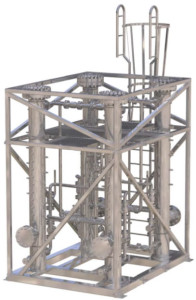Arsi-Guard™ Arsenic Removal from Natural Gas
Arsi-Guard™ is Newpoint’s proprietary catalyst based system for the removal of arsenic from natural gas. Arsi-Guard™ can reduce organic arsenic concentrations to below 1 ppb to eliminate environmental liability and improve primary catalyst performance in ammonia and LNG facilities.
 Benefits
Benefits
- Proven system that has treated over 750 billion cubic feet of gas
- Can reduce arsenic levels to less than 1 ppb
- Eliminates environmental liability
- Can effectively remove trialkylarsines (organic arsenic)
Newpoint’s Arsenic Removal Experience
The first arsenic removal system in the world was installed in 1988 at the Abo Field in New Mexico by principals at Newpoint Gas. After several trials, the resulting system has been on line and removing arsenic for over 19 years and treated a cumulative gas volume of 750 Bcf. Newpoint has experience in arsenic removal from 1200 µg/m3 (960 ppb w/w) inlet and a consistent residue concentration:
Arsenic Measurement
The ability to accurately measure arsenic concentrations in a gas stream has proven extremely difficult. Newpoint also offers arsenic measurement solutions utilizing a validated process with a 17 year history. We have procedures and equipment that can measure arsenic levels to less than 0.1 µg/m3.
History of Arsenic & Natural Gas
Arsenic has considerable economic impacts on the industries that utilize natural gas. Methanol, ammonia, and hydrogen plants all utilize catalysts that degrade over time due to the presence of catalyst poisons. The catalyst poisons, which include sulfur, mercury, and arsenic, degrade the performance of the system over time, reducing the capacity and efficiency of the plant. This has led to catalyst guard beds to remove sulfur and other catalysts poisons before the gas is introduced to the catalyst in the plants. In the case of arsenic, these guard beds have been reasonably effective in removing inorganic arsenic from the inlet natural gas stream; however, the organic arsenic compounds behave in a much less reactive manner and are not removed in the guard beds. The organic arsenic then reaches the catalyst and begins fouling it. The downtime associated with change-outs and the reduced capacity of plants due to catalyst fouling represent a considerable loss of income and a costly maintenance issue. The costs associated with arsenic fouling have been considered a “cost of doing business.” This is no longer the case; Newpoint’s ArsiGuard™ system has given the natural gas industry the tools to manage organic arsenic with low capital and operating costs. This treatment is efficient at ambient temperatures and can reduce organic arsenic concentrations to below 1 ppb.
Types of Arsenic found in Natural Gas
The most common form of arsenic in natural gas is not arsine (AsH3) but a group of arsenic compounds called the trialkylarsines (which includes: trimethylarsine, dimethylethylarsine, methyldiethylarsine, and triethylarsine – see table). The trialkylarsines are a considerably less reactive group than arsine and as such trialkylarsines are more difficult to remove from natural gas. These considerations and others make the arsenic problem difficult to solve. The natural gas industry is becoming more aware of arsenic contaminated natural gas and its potential legal and financial problems.
Arsenic Compound Concentrations in Natural Gas
| Compound | Percentage of Total Arsenic Compounds |
| Trimethylarsine (TMA) | 70% |
| Dimethylethylarsine (DMEA) | 20% |
| Methyldiethylarsine (MDEA) | 8% |
| Triethylarsine (TMA) | 2% |

